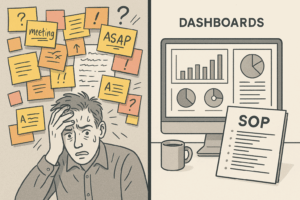In today’s competitive online landscape, visibility isn’t enough—you need attention, interest, and action. That’s where digital advertising comes in. Done right, it’s one of the fastest, most scalable ways to get in front of the right audience, drive qualified traffic, and generate high-converting leads.
While channels like SEO and content marketing are essential long-term investments, digital ads deliver immediate impact. According to WordStream, businesses make an average of $2 in revenue for every $1 spent on Google Ads, and the return can be even higher with precision targeting and creative optimization.
This guide explores why digital advertising matters, the best platforms to use, campaign strategies that work, and how to maximize ROI with smart targeting and data-driven decision-making.
Why Digital Advertising Works
Unlike organic content, digital advertising puts your brand in front of people exactly when they’re searching for a solution, scrolling with intent, or in a position to convert.
Key advantages include:
-
Immediate visibility: Appear in search results, social feeds, and high-traffic websites instantly.
-
Precise targeting: Reach people based on location, interests, behavior, and even purchase history.
-
Scalability: Ramp up or scale back based on budget and performance.
-
Measurable impact: Track every click, impression, lead, and sale.
According to Statista, digital advertising spending worldwide will surpass $740 billion by 2025, with search, social, and display ads leading the way.
Top Digital Advertising Channels for Lead Generation
1. Search Advertising (Google Ads, Bing Ads)
Search ads show up when users type queries into search engines. These are high-intent leads, often ready to take action.
-
Google Ads owns 27% of all digital ad spending globally (Statista).
-
Use keyword targeting to match your offers with buyer intent.
-
Best for: Local services, eCommerce, SaaS, professional services.
2. Social Media Advertising (Meta, LinkedIn, TikTok, X)
Social platforms offer rich audience targeting and visually engaging ad formats. These ads are effective for brand awareness, lead capture, and retargeting.
-
Meta (Facebook + Instagram) offers targeting by interests, behaviors, demographics, and even life events.
-
LinkedIn Ads are especially powerful for B2B—79% of B2B marketers rank LinkedIn as the best channel for lead generation (LinkedIn, 2024).
-
TikTok ads have seen a conversion rate increase of 155% year-over-year in key industries (WordStream).
3. Display Advertising (Google Display Network, Programmatic Platforms)
Display ads appear on websites, apps, and YouTube channels, reaching users who may not be actively searching but fit your ideal audience.
-
Best for top-of-funnel awareness and retargeting.
-
Use eye-catching visuals and strong call-to-actions (CTAs).
-
Over 90% of internet users are reached by Google Display Network, according to Google.
4. Video Advertising (YouTube, Social Video)
Video ads combine storytelling with visual engagement. They’re great for capturing attention and educating your audience.
-
YouTube is the second-largest search engine and has 2.5+ billion users.
-
Video ads boost conversions by up to 86% when paired with landing pages (Unbounce).
5. Retargeting (Pixel-Based and List-Based)
Retargeting ads reach people who’ve interacted with your site or content but didn’t convert. These leads are warm—and statistically more likely to buy.
-
Facebook retargeting ads can increase conversion rates by up to 70%, per WordStream.
-
Add tracking pixels to your website to build remarketing audiences automatically.
Building a Digital Ad Campaign That Converts
Digital advertising isn’t just about turning it on—it’s about turning it into a growth machine. Here’s how.
1. Define Your Campaign Objective
-
Lead generation
-
Website traffic
-
Product purchase
-
Brand awareness
Start with one clear objective to guide ad format, targeting, and messaging.
2. Know Your Audience
Use buyer personas, website data, and analytics to build a clear picture of:
-
Who your ideal customer is
-
What problems they need solved
-
Where they spend their time online
Tip: Use lookalike audiences on platforms like Facebook and LinkedIn to scale your targeting to people similar to your best customers.
3. Develop Magnetic Messaging
A high-converting ad speaks directly to your audience’s pain points or goals.
-
Use attention-grabbing headlines
-
Offer a strong, specific value proposition
-
Include a call-to-action (CTA) that drives urgency
Example: “Get 3x More Leads in 30 Days – Book Your Free Strategy Call Today”
4. Design a Conversion-Optimized Funnel
Don’t send paid traffic to your homepage. Use a dedicated landing page with:
-
A clear headline
-
Supporting proof or benefit
-
A form or call button
-
Minimal distractions
Unbounce reports that landing pages with fewer than five form fields convert up to 160% higher than those with more.
Metrics That Matter: How to Measure Performance
Tracking results is essential to improving them. Here are the key performance indicators (KPIs) to monitor:
-
Click-Through Rate (CTR) – Measures ad relevance
-
Cost Per Click (CPC) – Helps optimize budget
-
Cost Per Lead (CPL) – Shows how efficiently you’re acquiring leads
-
Conversion Rate – The percentage of users who take action
-
Return on Ad Spend (ROAS) – Total revenue generated per dollar spent
Tools like Google Ads Manager, Meta Ads Manager, and platforms like HubSpot, Google Analytics, and Hotjar help track user behavior post-click.
Common Mistakes That Drain Ad Spend
Avoid these pitfalls to stretch your ad budget and maximize lead quality:
-
No clear goal or funnel
-
Poor landing page design
-
Targeting too broadly
-
Failing to test creative and messaging
-
Ignoring ad fatigue or frequency caps
-
Skipping retargeting opportunities
According to WordStream, small businesses waste 25% of their PPC budget due to poor targeting and lack of testing. A/B testing and optimization aren’t optional—they’re mandatory.
Scaling Your Digital Ad Strategy
Once your campaigns are profitable, it’s time to scale:
-
Increase budget gradually: Scale winning campaigns 10–20% at a time
-
Expand to new platforms: Add LinkedIn, YouTube, or programmatic when ready
-
Repurpose creative: Adapt winning messages into new formats (carousel, video, etc.)
-
Layer on email and SMS marketing: Use lead magnets and nurture flows to convert leads post-click
Real-World Results from Digital Advertising
-
A small HVAC company saw a 4x increase in leads within 60 days after launching Google Ads with hyper-local targeting and mobile-optimized landing pages.
-
A B2B SaaS brand achieved a 78% drop in CPL by shifting budget from display to LinkedIn and using a gated eBook funnel.
-
An eCommerce startup boosted email opt-ins by 220% through Facebook lead ads paired with a limited-time offer.
Final Thoughts
Digital advertising, when executed strategically, offers more than visibility—it offers velocity. It moves your business forward faster by placing your offer in front of the right people at the right time, with the right message.
But the magic is in the details: audience precision, creative quality, campaign structure, and relentless optimization. Businesses that commit to testing, measuring, and refining don’t just run ads—they build scalable lead machines.
Whether you’re running your first campaign or scaling up existing efforts, digital ads can unlock growth faster than nearly any other channel—if you’re ready to treat it like a real system, not a one-time expense.
Sources:







